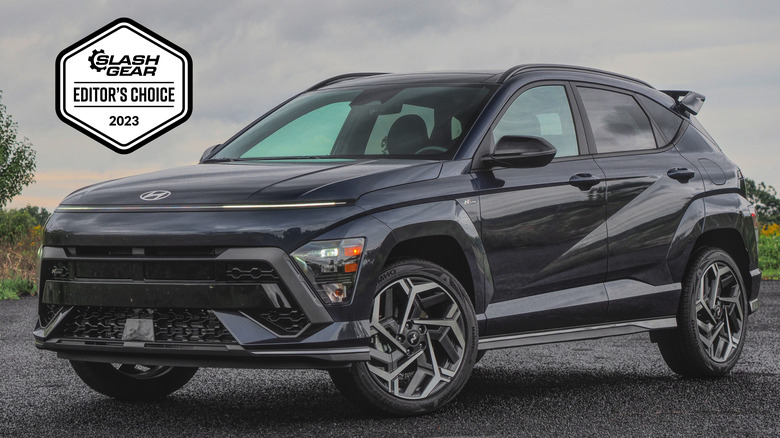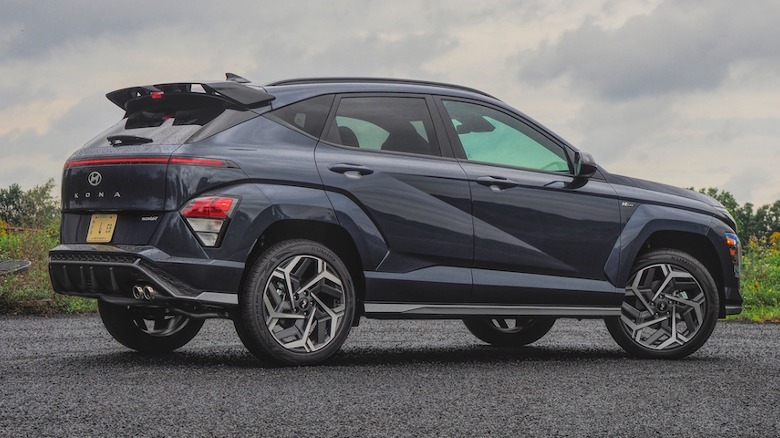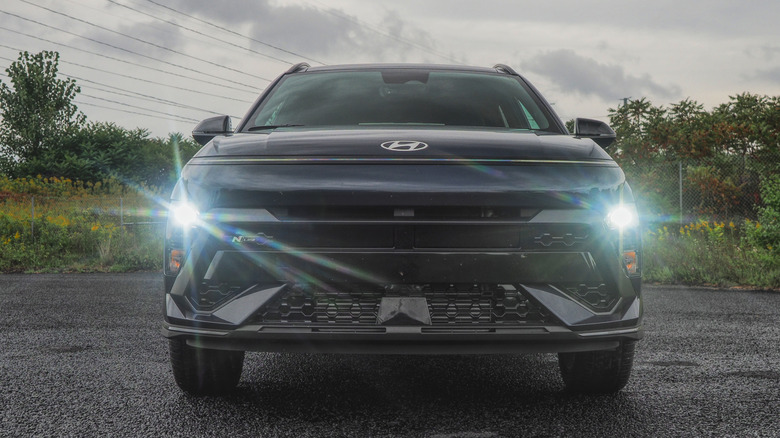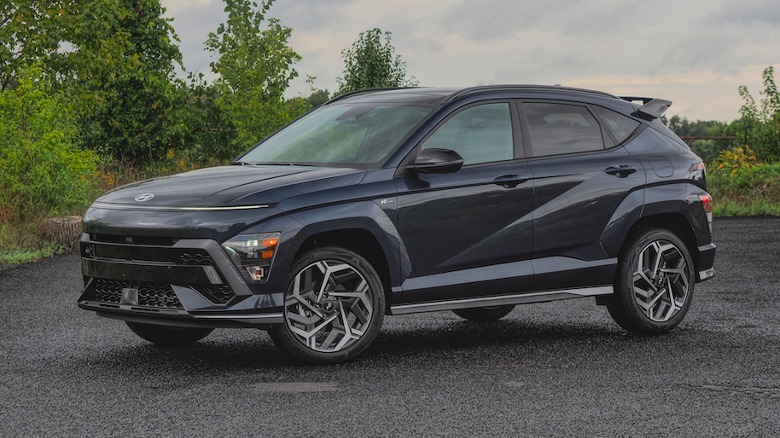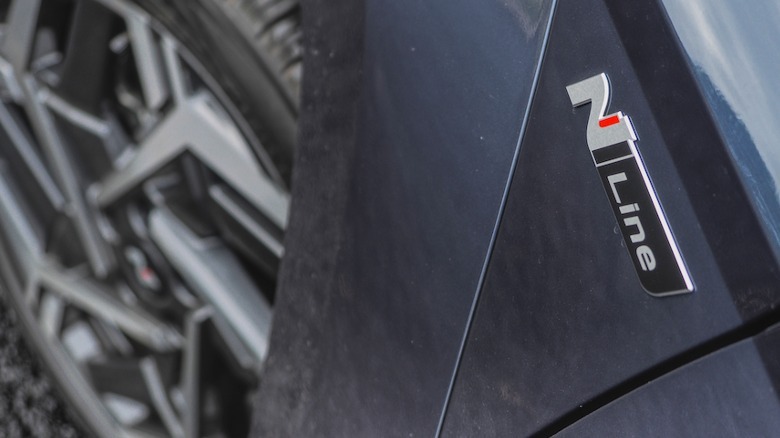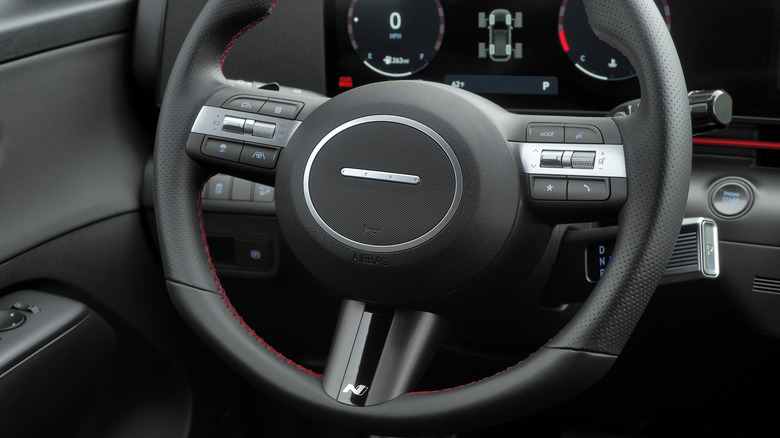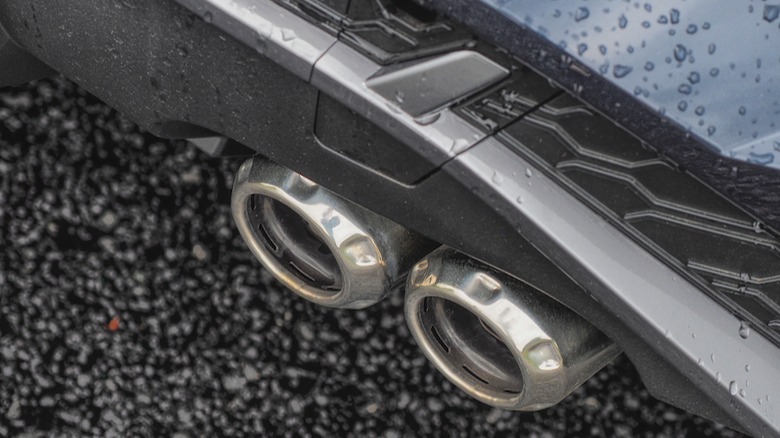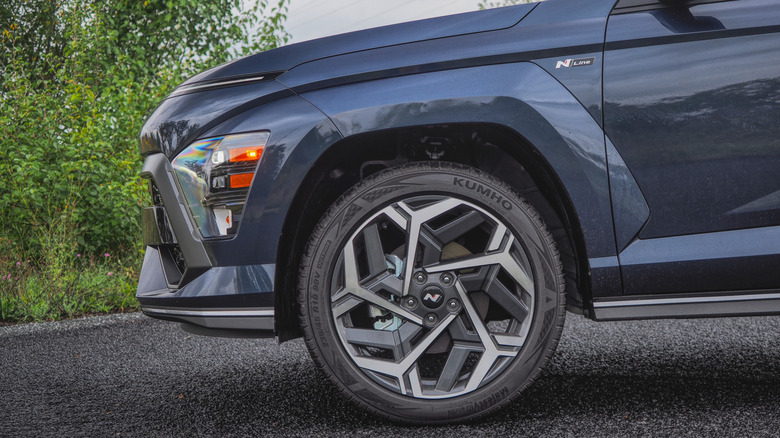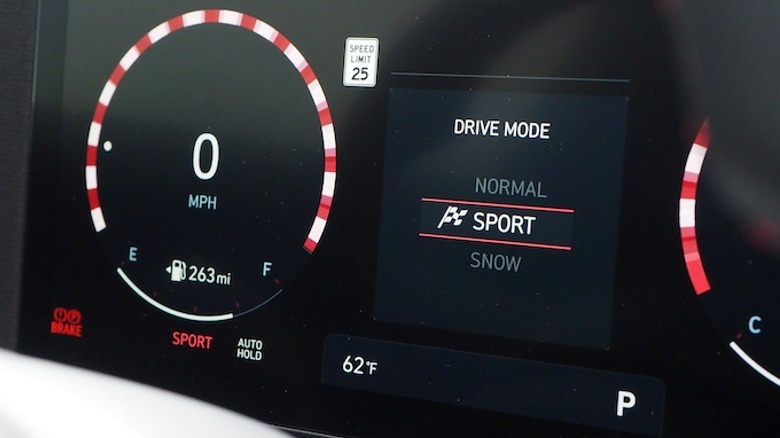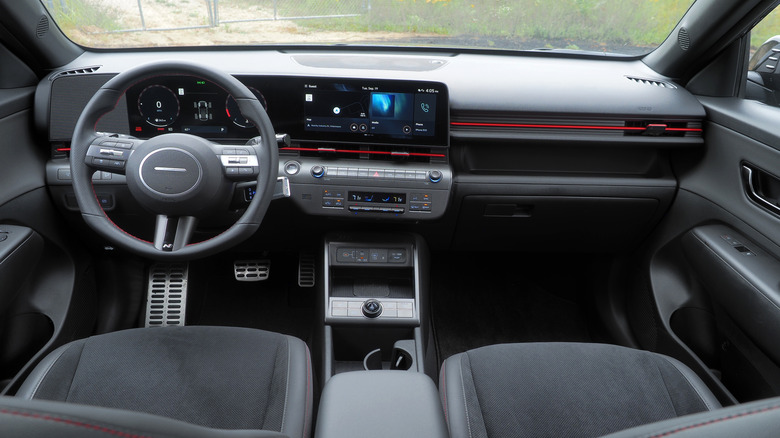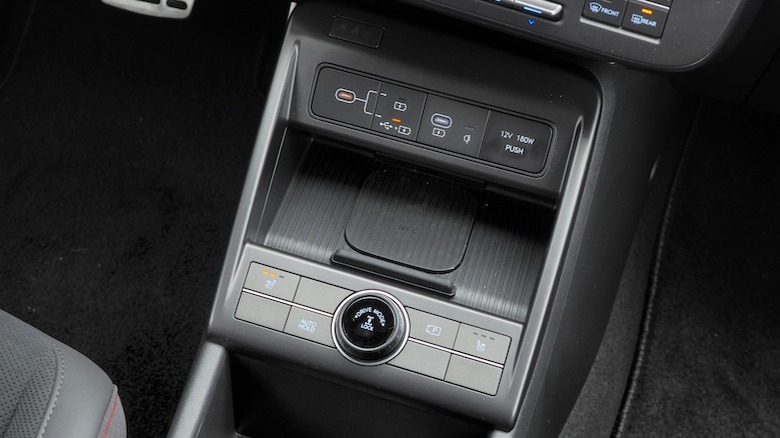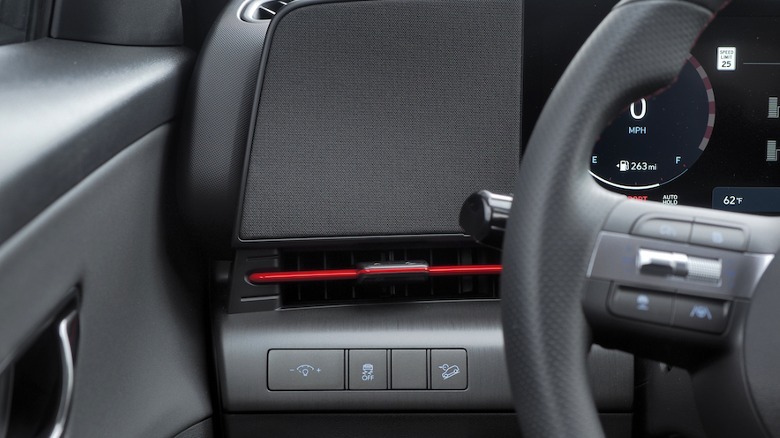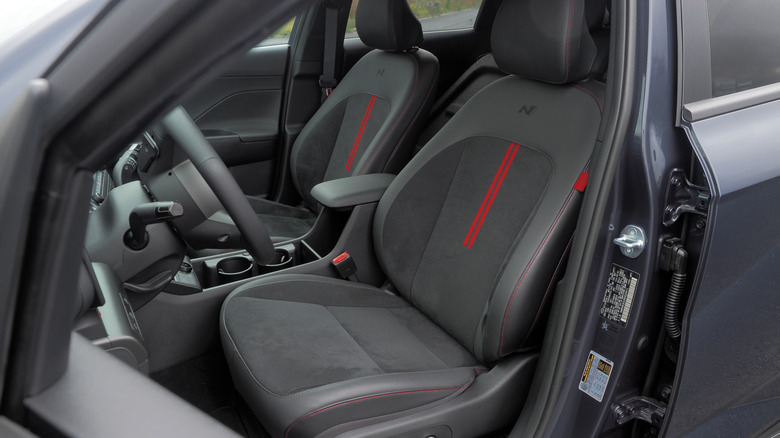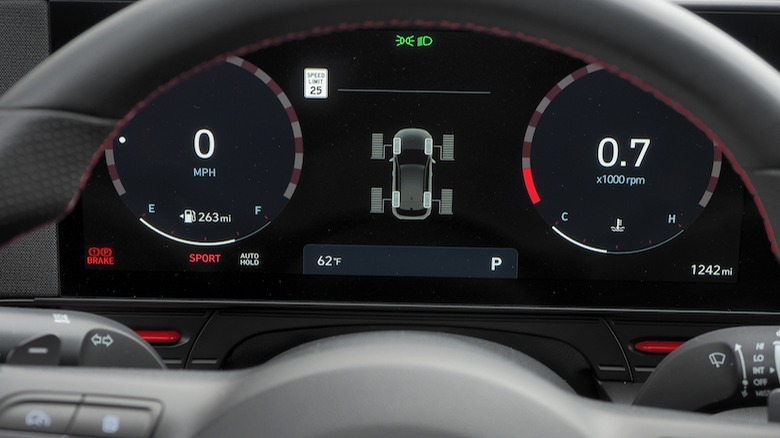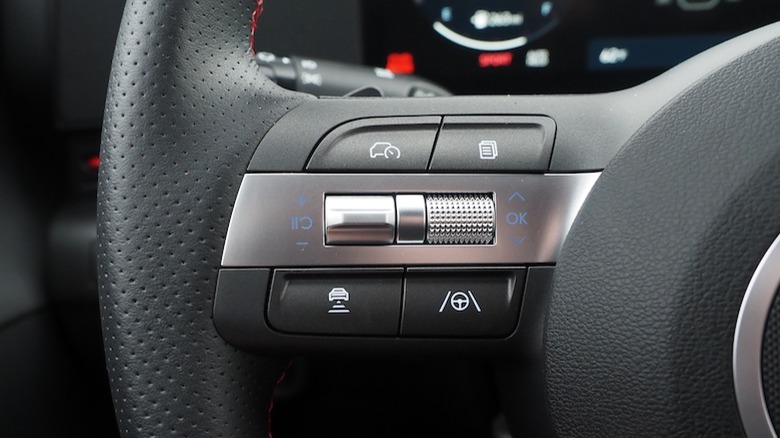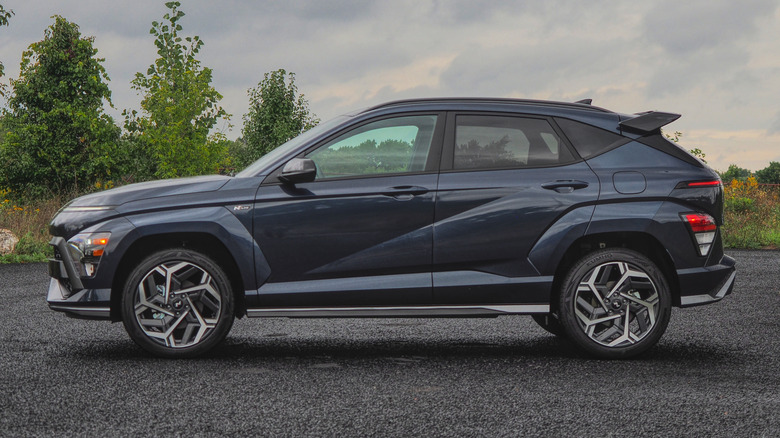2024 Hyundai Kona N Line Review: Bigger, Bolder, Better
- Bold styling for a practical size increase
- Turbo engine is punchy and reasonably economical
- Fresh-looking dashboard with plenty of tech
- Wired smartphone projection (for now)
- America doesn't get the Kona Hybrid
- Please, Hyundai, give us a true Kona N
American drivers don't hate small cars, they just don't particularly enjoy being reminded that they're driving one. Witness, by way of example, the current crop of subcompact crossovers: all scaled to suit urban and suburban owners alike, yes, but generally dressing their diminutive practicality in the aesthetic of bigger, thirstier, and usually more expensive SUVs that automakers know buyers are drawn to.
It's a strategy Hyundai has taken to heart with the 2024 Kona N Line. Even if the original Kona felt a little like a hatchback indulging in crossover cosplay, the dress-up strategy clearly worked: in the U.S., it was the automaker's fifth most popular model in sales last year. Aggressive pricing and a healthy warranty certainly didn't hurt, either.
For the 2024 Kona, the second-generation crossover leans into a winning strategy, with an emphasis on strategic. The new Kona makes sure to focus on addressing some of the biggest criticisms of the old model.
Size doesn't matter, it's what you do with it that counts
If the first-generation Kona had a fascia like a disgruntled snake, for this second-generation crossover, the snake goes to space. The squinting daytime running lights have narrowed further still, into a hood-spanning light bar, while Hyundai offsets the curves with chunky, angular arches and sharp crease lines. Ground clearance has increased for 2024, too, now at 8.3 inches, though I'd be wary of taking the Kona's fancy wheels off-road.
19-inch N Line design alloy wheels are standard on this $30,650 (plus $1,335 destination) N Line trim, as are twin-tip exhaust pipes and a fetching spoiler atop the hatchback rear. The result is modern and positively funky, and while Hyundai's paint options for the Kona N are all fairly sober — unlike the 2024 Kona Limited trim, from $31,650 plus destination, which has vibrant yellow and orange available on the order sheet — there are some handsome two-tone finishes with a contrast black roof.
It's a bigger crossover than the old Kona, almost six inches longer as well as being taller and wider. That's not unusual for the auto industry — size sells, after all — but Hyundai's decision to put most of the 2024 Kona's extra length into expanding trunk capacity rather than second-row spaciousness is atypical. Not unwelcome, however, given the resulting 25.5 cu-ft for cargo feels much more competitive in the Kona's segment.
A turbo worth spending extra on
The cheapest 2024 Kona models will use Hyundai's 2.0-liter naturally-aspirated inline-four gas engine, with front-wheel drive; the SE trim will kick off at $25,435 (plus destination). The 2.0-liter pipes its 147 horsepower and 132 lb-ft of torque through a continuously variable transmission (CVT).
Tucked behind the Kona N Line's squinting light bar is another familiar engine, the 1.6-liter turbocharged inline-four. Here, it brings 190 horsepower and 195 lb-ft of torque to play, with standard front-wheel drive or — for $1,500 more — Hyundai's HTRAC AWD system that powers all four wheels. An eight-speed automatic transmission is standard either way.
The result is perky, though not likely to set the world alight. After all, this is an N Line car, not a full "N" badged model: currently, Hyundai is selling the old (and excellent), 2023 Kona N alongside this new 2024 Kona N Line, and won't be drawn on whether there'll be a new Kona N to replace it.
Firm, but leaving us dreaming of a new Kona N
Still, the 1.6 turbo is a pleasingly punchy little fellow, and it makes the Kona N Line both a grand urban runabout and a decent highway cruiser too. The eight-speed can be left wrong-footed on downshifts when it comes to sudden acceleration, though nothing a snap of the paddle shifter can't override, but generally, there's more than enough torque to take advantage of in impromptu stoplight races and highway-pace overtaking opportunities.
It's a smooth ride, too, though, without fancy adaptive dampers, the standard suspension tune errs on the side of slightly firm compliance. That suits the N Line nicely, holding rough road surfaces at arm's length without feeling unduly squishy, though the Kona is no corner carver. Push harder, and you're reminded that the sporting body kit is more for show than to coax out any performance car pretensions.
The standard front-wheel drive Kona is EPA-rated for 26 mpg in the city, 32 mpg on the highway, and 28 mpg combined. Switch to the all-wheel drive version, meanwhile, and those numbers dip to 24 mpg city, 29 mpg highway, and 26 mpg combined. In other markets, Hyundai offers a more frugal Kona Hybrid, but drivers in the U.S. will have to choose between all gas or all-electric.
An EV-inspired cabin
It's clear much of Hyundai's EV design language has been donated to the newest Kona, particularly in the cabin. The unusual, block-like transmission selector — which you twist to shift between drive and reverse — is reminiscent of what you'll find sprouting from the steering column in the Ioniq 6. Hyundai's four-dot styling cue is borrowed for the steering wheel hub, and there's a pleasing willingness to embrace straight lines and (better still) eschew gloss black plastic.
For the 2024 Kona, though, Hyundai flirts with some retro detailing as well. The speaker grilles, upright and squared-off, bring to mind classic Bang & Olufsen BeoSound hi-fi systems, particularly with the red piping that spans the Kona N's dashboard. Then there are things like the selectable charge or data settings for the front USB-C ports, with graphics that look straight from an old school electronics textbook.
The end result is both distinctive and easy to use, and it's hard to ask much more than that from a car dashboard, really. Hyundai tops it all with a pair of 12.3-inch displays — one for the driver's gauges, the other a touchscreen for the easy-to-use infotainment system — though its Android Auto and Apple CarPlay support remains, frustratingly, wired rather than wireless. At least Hyundai says it can address that, this time around, with a future OTA (over-the-air) update.
The safety and ADAS tech of much bigger cars
Kona N Line trim cars get N Line Sport Combination seats, with grippy, suede-like panels. Kona Limited swaps that for leatherette; both get a leather-wrapped steering wheel. An 8-way power driver seat is standard, as are heated front seats and a 60/40 split rear bench. Only the Limited trim gets ventilated front seats; there's not even the option to add them to the N Line.
All 2024 Kona trims get dual front and dual rear USB ports, along with a power sunroof, digital key, wireless phone charging, and dual zone climate control with rear seat vents. Navigation-based adaptive cruise control is standard, but only the Limited trim gets a 360-degree camera and Hyundai's Blind-Spot View Monitor system which beams a view from side-mounted cameras to the driver display when you hit the turn signals to change lane.
Still, blind-spot collision-avoidance warnings are standard across the board, as is rear cross-traffic collision-avoidance assist; forward collision-avoidance assist with pedestrian detection, cyclist and junction turning detection's and direct oncoming traffic detection; lane following assist and lane keeping assist; driver attention warning; and safe exit warning.
Highway Driving Assist (HDA), Hyundai's capable hands-on driving assistance that helps keep the Kona centered in the lane (and which actually works off highways, too, as long as the road markings are up to scratch) is standard on both N Line and Limited trims.
2024 Hyundai Kona N Line Verdict
Headed to dealerships later this year, meanwhile, the 2024 Kona Electric will give Hyundai its cheapest full EV. Undercutting the Ioniq 5 and Ioniq 6 — pricing is yet to be confirmed, though the outgoing version starts at under $34k — it'll have big shoes to fill, though up to an estimated 260 miles of range on a charge is a good place to start.
Not everyone is ready for an all-electric life, though, and there the gas-powered Kona feels far more ready for duty on American roads. The larger scale and ensuing uptick in practicality, healthy combination of comfort equipment and standard safety technology, and distinctive aesthetic feel better targeted than the original ever did.
Though it'll cost you more, opting for the turbocharged engine is going to deliver a more rewarding ownership experience, too. Even if you don't want, or need, that extra power, however, it's tough to argue with Hyundai's standard 5-year/60,000-mile limited vehicle warranty. The heart may hold out hope for a new Kona N, but the head can't really argue with the overall package that the 2024 Kona N Line delivers.
